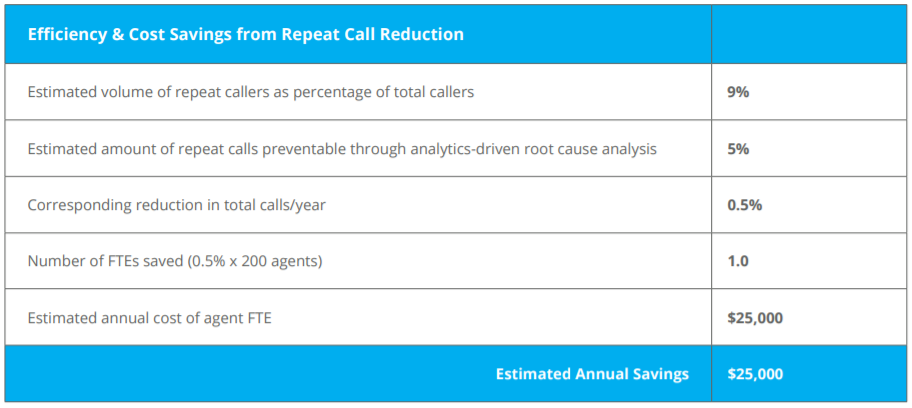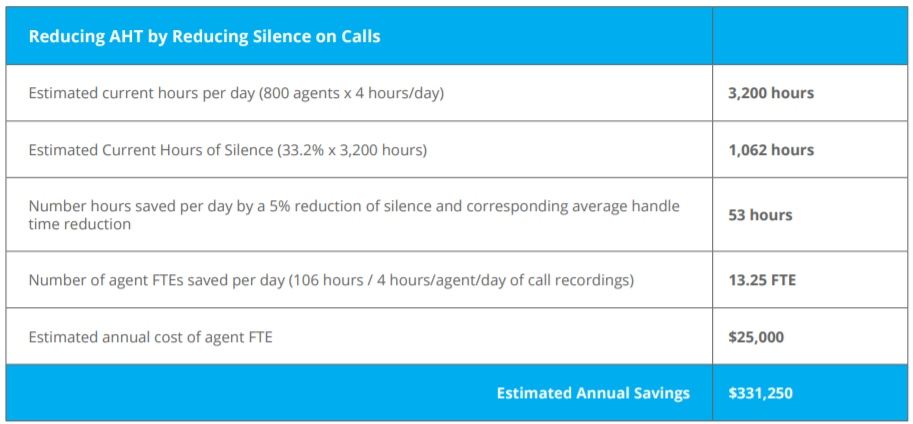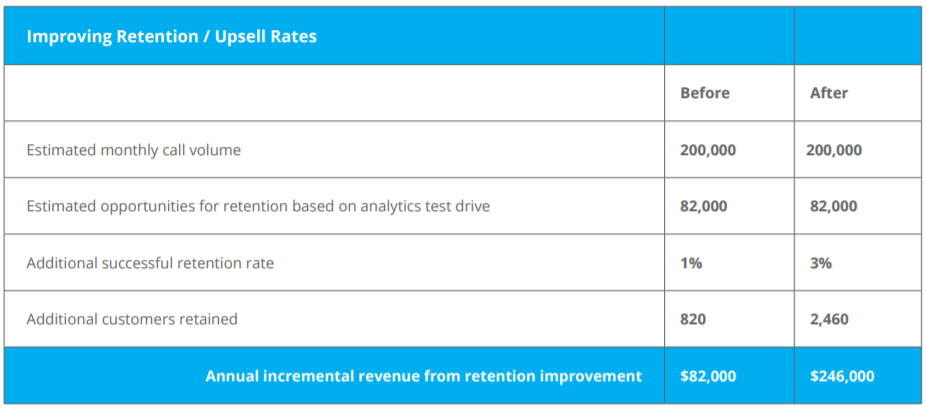

A contact center manager considering a move to CallMiner’s interaction analytics technology will no doubt have to put together a reasonable business plan to justify the investment. The manager will need first to define and quantify the most relevant benefits for their contact center situation, making sure they are understandable and measurable. In this paper, we provide recommendations on how to zero in on benefits that best apply to your situation, and on ways to factor these benefits into a simple business plan.
A manager can start things off by reviewing the CallMiner website. The site has tons of relevant content showing the benefits of their speech analysis software and how one can go about estimating value. From there, the manager can turn to their CallMiner support partner. As a support partner of CallMiner[1], our objective is to assist our clients in defining benefits most relevant for them, and in clearly understanding the contribution each can make to a positive business plan.
There are two major points we emphasize to our clients:
First point: initially, try to restrict the benefits considered to top 3.
Assess and rank potential benefits to determine the top 3 most relevant to the initial implementation, often called ‘low hanging fruit’. Down the road, as additional use cases are tackled, new benefits will come into play, but to start with, our recommendation is to keep it simple.
Second point: keep the business plan as a live ‘roadmap’.
Keep the business plan up to date, with all benefit metrics tracked via actuals over time. This allows the organization to see the financials evolve as the technology is applied to more use cases. While initial benefits must meet a minimum-required payback threshold to get things started (get senior mgt. approval), the real payoff happens down the road as more use cases are accomplished. Keep in mind – the benefits of CallMiner technology are ongoing and not one-shot. As an important part of our support we work with clients to keep the business plan up to date and accurate using actual KPI tracking data.
This white paper explains how interaction analytics creates value and rapid ROI with examples from real-world deployments. Macrosoft is prepared to support our clients in generating and maintaining a simple and compelling business plan for CallMiner technology.
CallMiner Technology
CallMiner believes that responsive problem resolution is a fundamental driver of positive customer experience. When contact center agents and others responsible for customer engagement are enabled by insight and feedback in real-time or ex-post, they can dramatically improve the rate and speed of positive outcomes. Thus, the tagline “Listen to Your Customers, Improve Your Business”.
CallMiner’s goal is to help companies automate the complex process of extracting insight from phone calls, chats, emails and social media to dramatically improve customer service and sales, reduce the cost of service delivery, mitigate risk, and identify areas for process and product improvement. Highlighted by multiple customer achievement awards, CallMiner has consistently ranked highest in customer satisfaction, including in surveys conducted by DMG Consulting and Ovum.
CallMiner, and speech technology in general, are clearly enablers of moving companies in the imperative strategic directions of automation and digital transformation, but each step along the way needs to be justified by its own business plan and positive financials and have a quick return to investment.
Your Contact Center
Clearly, there are financial benefits to be had from CallMiner technology. The challenge for the manager is to define and quantify those benefits. At the topmost level, contact centers can utilize CallMiner to reduce operational costs and/or to increase efficiency or effectiveness. In both instances, the analytical capabilities of CallMiner are used to optimize how client interactions are handled.
By analyzing the content and outcomes of contact interactions across all channels (calls, emails, messaging, chats, social media), organizations can manage the interaction flow more efficiently, maintain contact center staffing at optimal levels, enhance the customer journey across channels and resolve individual engagements more effectively. The primary goal in all of this work is for the manager is to help direct a true path to return on investment for the organization.
As noted earlier, managers should avoid what we call ‘boiling the ocean’ at the beginning of an implementation. Using interaction analytics provides the ability to analyze all interactions between the contact center and customers, and when people are first presented with this, they almost immediately think of 20-30 things to do with it. This is not the way to go in the initial assessment to justify implementation.
We recommend a manager select only a few benefit types to begin with. Instead of taking on too much too quickly, a company should restrict the initial view to at most three benefit areas. Use these to prove the value of using CallMiner interaction analytics. The immediate goal is to get the proof ‘hurdle’ out of the way early on so that you can concentrate on maximizing the benefits of using analytics. This is where we come in – we help our clients identify and determine the top benefits and assist them in making a list of secondary benefits that can be kept in the back pocket till needed.
Some Top Benefit Areas
Here are three potential areas of benefits that can form the basis of your initial business plan.
- Compliance (making sure you mitigate the risk of being fined)
By focusing on compliance, you can make an immediate difference. You can identify any areas of risk, develop best practices and be certain that all your agents’ interactions comply with legislation – and prove it if asked.
There are two ways in which you can minimize or eliminate these risks. First, you can analyze every call or contact with a customer to identify where your compliance procedures have not been followed.
As part of this you can also identify the words or language that is normally associated with these non-conformances. This will help you understand your risk exposure and enable you to put in place the training to ensure that the entire agent team understands what is required to be compliant.
Identifying language associated with risk provides another advantage. A manual sampling of recorded calls provides little or no prevention of non-compliant behavior or protection against litigation. But a live interaction analytics solution can provide the ability to monitor in-progress calls for the presence or absence of specific language that relates to a breach in compliance and alert the agent or supervisor before the situation escalates.
- Automation and efficiency
Automation and efficiency focus on cutting the cost of customer interactions and optimizing agent performance.
By focusing here, you can identify how to make a variety of improvements and realize savings. These include lowering agent turnover, reducing handle time and driving more self-service. Most people concentrate on this first – as it’s easiest to understand – making calls shorter and more effective.
The ability to automatically record, analyze and score every call helps reduce the training period and time-to-value for new employees. Trainers and managers can use daily scorecards and real-time feedback to customize instruction and coaching. This not only helps new hires become productive faster, it also reduces their confusion and improves confidence, which in turn reduces dissatisfaction and attrition. Customized coaching also helps produce sustainable, continuous quality and productivity improvement.
- Sales Increase
Companies lose untold revenues because many do not have the analytics they need to develop best practices and agents do not consistently follow developed scripts. High conversion rates result from high consistency in the sales approach. Comprehensive monitoring and analysis through analytics help produce the consistency that increases conversions.
Analytics makes it easier to identify successful selling techniques and identify customer objections. Organizations can then use the insight to target their offer, sales presentation and agent training to better address leading objections. Interaction analytics also helps organizations to understand where missed opportunities happen. For example, one company polled its sales reps regarding whether they were performing the upsell that was being promoted.
Ninety percent of the agents said they were promoting the upsell, but analysis by interaction analytics found only 50 percent were doing so. Interaction analytics is also a very useful and powerful tool for testing marketing campaigns to determine what messaging and activity will produce the best results.
Primer on Business Plan
Here are some basics to consider in preparing your business plan.[2]
- Focus on a Net Return approach rather than simply ROI
Improvements derived from speech analytics are not one time, but recurring every year, and increase as more use cases are added to the mix. Moreover, ROI is a ratio and does not determine the magnitude of financial gain.
- Direct and Indirect Savings
For benefit categories in business plan, be sure to include both direct and indirect savings. Direct savings include reductions in staff, avoidance of regulatory fines. Indirect savings include increasing worker and manager effectiveness from streamlining process and tools.
- Measurable Business Plan
Benefits and costs need to be measurable, and actuals need to be tracked and input to the business plan on a regular basis. This needs to be done not only during initial implementation but also subsequent years as new uses cases are added.
- Maintain List of Benefits with non-financial value
Many benefits are hard to measure financially but can have a big impact on the company. the manager needs to keep a working list of these benefits that are commonly recognized as important to the company. Examples include increased positive brand awareness, agent and customer morale improvement.
As noted, it is best to keep the business plan as a living document, updated regularly even once the initial decision to proceed is made. We work with our clients to update the plan on an ongoing basis, especially so new enhancements and expanded use cases are properly reflected.
Three Examples of Benefits
This section provides 3 simple use cases of benefit types that are often important to the business plan for Call Miner.
- Reduce First Call Volume
Analytics helps reduce costs by giving organizations the insight to reduce repeat call volume. Root cause analysis with interaction analytics can reduce repeat calls by 3 – 5%. Reducing repeat calls not only reduces overall call volume, it also leads to greater customer satisfaction. These improvements reduce the average cost per contact, while also improving customer satisfaction.
One company did a “test drive” of interaction analytics to get baseline metrics about its 200-agent contact center. The company learned that approximately 9% of the people that called its contact center were repeated callers. It estimated that analytics could be applied to reduce repeat callers by 5 percent, which would be enough to eliminate one full-time equivalent (FTE) position, or re-direct the individual to much higher value work.
The company documented the value of repeat call reduction using the following worksheet.

- Reducing Silence on Calls
One company that has 800 agents estimated that reducing silence by just 5% on its calls would produce $331,250 in annual savings, as shown in the calculation below.


- Improving Retention and Upsell
A top-10 US cable provider used its interaction analytics data to build a model that predicts which customers are most likely to churn. The predictive analytics helps guide customer retention and customer acquisition strategies. Another company calculated it could improve its retention rate by 2 percent, which would produce $246,000 in incremental revenue annually, as shown in the table below.


Summary Remarks
Interaction analytics produces return on investment by providing the insight to improve agent productivity and performance, avoid costs from compliance violations, and increase revenues by enabling more effective and consistent customer interactions.
- By analyzing numerous data points from 100 percent of contacts, analytics produces insight that is more detailed and comprehensive than what is possible from random sampling and other traditional contact center management methods. Interaction analytics produces value in many ways, including
- Raising quality and consistency in customer contacts
- Improving agent and supervisor efficiency
- Reducing risk of compliance violations
- Increasing revenue through higher close rates, greater customer retention and more effective sales management
- Improving customer service and satisfaction throughout the customer journey
We hope this paper will help you quickly prepare a good business plan on CallMiner, and then gain approval from senior management for a rapid startup, so your contact center can gain these important benefits as soon as possible!
[1] Macrosoft is a technology support partner of CallMiner. In contrast to other partners, our sole focus is to provide technical support and maintenance. We do not sell or recommend other contact center technology.
[2] A good source of information on business plan is contained in the white paper “Calculating and Explaining the ROI for Your Project”, Call Miner White paper, Shane Lauber and Bryan Trice.
ByRonald Mueller, Allen Shapiro | Published on October 27th, 2020 | Last updated on July 15th, 2024 | CallMiner

 Home
Home Services
Services








































